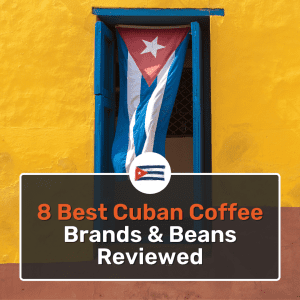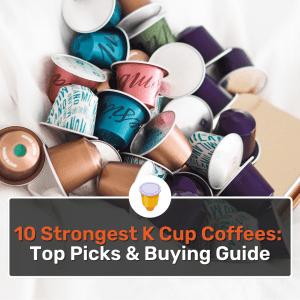- Why Should You Grind Your Own Coffee?
- Why Does Grind Size Matter?
- What Is Over/Under Extracted Coffee?
- Which Grind Size Should You Use?
- Which Grinder Should You Use?
- Frequently Asked Questions
- Can I Grind My Coffee Beans In A Blender?
- How Do I Know If I’m Using The Correct Grind Size?
- Do I Need To Grind Coffee Beans Fresh Every Day?
- How Quickly Does Ground Coffee Lose Its Freshness?
- Does A Finer Grind Make Coffee Stronger?
- What Grind Size Should I Use For French Press?
- What Grind Size Should I Use For Pour-Over?
- What Grind Size Should I Use For Chemex?
- What Grind Size Should I Use For AeroPress?
- What Grind Size Should I Use For Cold Brew?
- What Grind Size Should I Use For Espresso?
- What Now?

Many coffee enthusiasts still underestimate the importance of a fresh grind, but once you master the skill you’ll never want to go back. But like anything rewarding, there has to be some challenge.
I’ve spent the past few years tinkering and adjusting my grinder to figure out what works for me, so I’ve got you covered.
This coffee grind size chart has everything you need to take you from amateur to pro. I’ll cover the importance of a fresh grind, why grind size matters, how fine to grind your coffee, and much more, so keep reading to find out more.
Why Should You Grind Your Own Coffee?

Grinding your coffee beans before brewing ensures maximum freshness and flavor. The reason for this is that coffee beans are like any other organic product. Flavors are affected by external conditions. When coffee beans are ground the oxygen enters the cells and they start to react, this activates the flavor.
Even 15 minutes after grinding coffee it can start to lose its flavor. The longer it’s left out the staler it gets and the taste deteriorates. This does mean that you’ll have to keep your grinder handy for each brew, but it’s a small trade-off for a great cup of coffee.
Would you rather eat fruit cut and left out for hours before consuming or freshly chopped? We’d all prefer the latter because it tastes sweeter and less dried out.
Grinding your coffee also allows you to experiment with different grinds and methods of brewing. Each cup of coffee is unique and you can make yours personal to your tastes and preferences.
Why Does Grind Size Matter?

The grind size is determined by the brewing method or extraction process. The extraction rate is how much of the coffee flavor and caffeine is extracted from the beans as water passes through.
When coffee beans are ground finer, the extraction rate increases as a larger surface area is exposed. This also reduces the flow rate (how quickly water passes through the grind) as the grinds fit together more compactly. Contact time (how long the water is in contact with the coffee molecules) is increased as a result.
To keep it simple, the finer the grind, the less contact time is needed as the surface area is larger. Longer brews will require coarser grinds. See the table below to help you visualize it better.
| Grind | Extraction Rate | Flow Rate | Contact Time |
| Fine | Quicker | Lower | Increased |
| Coarse | Longer | Higher | Decreased |
What Is Over/Under Extracted Coffee?

As we’ve determined so far, the main factor that impacts extraction is the grind size. Brewing coffee is a science and sometimes it doesn’t always turn out how you expected. Knowing how to troubleshoot your brew can be a valuable skill.
Under-extraction can be recognized by its sour and acidic taste. It is the result of a grind that is too coarse. You can correct this by using a finer grind to balance the flavor intensities. It occurs when the water passes through the grind too quickly and can’t pick up enough flavor.
Over-extraction can be recognized by its bitter and overpowering flavor. It occurs from a grind that is too fine and can be corrected by using a coarser grind to neutralize the harshness. It occurs when the water passes through the grind too slowly and picks up too much flavor.
You should aim for a balanced extraction that allows you to taste all the flavor tones of your beans. Use this table to help you get your brew a perfect cup each time!
| Extraction | Flavor | Brew Time | Grind |
| Under-extracted | Sour/Acidic | Increase | Finer |
| Over-extracted | Bitter/Overpowering | Decrease | Coarser |
Which Grind Size Should You Use?

Here are the 7 main coffee grind sizes.
Extra Coarse
Extra coarse grind coffee has the texture of kosher sea salt or peppercorns. It is commonly used for a cold brew and cowboy coffee.
Coarse
Coarse grind coffee has the texture of sea salt. It is commonly used for French press, coffee cupping, and percolators.
Medium-Coarse
Medium-coarse grind coffee has the texture of rough sand and table salt. It is commonly used for drip coffee, Chemex, clever dripper, and Cafe Solo.
Medium
Medium grind coffee has the texture of regular sand. It is commonly used for drip pots, cone-shaped pour-over brewers, siphon coffee, AeroPress, and flat bottom drip coffee.
Medium-Fine
Medium-fine grind coffee has a finer texture than sand. It is commonly used for AeroPress and cone-shaped pour-over brewers.
Fine
Fine grind coffee has a finer texture than table salt. It is commonly used for espresso, AeroPress, Moka pot, and stovetop brewers.
Extra Fine
Extra fine grind coffee has the texture of powdered sugar or flour. Its main use is for Turkish coffee.
Which Grinder Should You Use?

There are 2 main types of grinders: blade and burr. Blade grinders are an affordable and easy solution for most. But, blade grinders are terrible for your coffee beans!
They provide a fast but messy result, with an inconsistent grind. Some coffee beans will end up over-extracted and some under-extracted. Blade grinders create heat and friction from the rotation of the blades and can ruin your coffee beans. It will give them an overcooked, burnt flavor.
Burr grinders are ideal for grinding your beans. They crush the beans evenly with a grinding wheel, between spinning burrs. Unlike blade grinders, burr grinders give you a lot more control over your grind size. Allowing you to make finer adjustments to give you your desired grind size. Burr grinders preserve the flavor of the beans as they do not overheat like blade grinders.
There are 2 types of burr grinders, wheel burr, and conical burr. Wheel burr grinders are cheaper and can be messier as they rotate quicker. Conical burr grinders are the better of the 2. Burrs spin more slowly so are less likely to clog. If you’re a big coffee enthusiast like myself, you may want to invest in an automatic burr grinder.
Frequently Asked Questions
Can I Grind My Coffee Beans In A Blender?
It isn’t recommended that you grind your coffee in a blender. You will get a messy result with an inconsistent grind. Beans will be under and over-extracted and the friction will overcook your beans, ruining the flavor. Pre-ground coffee may be a better solution in this case, a cheaper manual coffee grinder will also do the trick.
How Do I Know If I’m Using The Correct Grind Size?
You can work out the correct grind size from the brewing method of choice. Longer brewing methods will require coarser grinds. Shorter brewing methods will require finer grinds. Your taste and preference will play a part in this too, so don’t be afraid to adjust as you go.
Do I Need To Grind Coffee Beans Fresh Every Day?
If you want the best flavors and experience it is recommended to grind your coffee beans before every brew. Coffee starts to lose its flavor even after just 15 minutes. An automatic burr grinder can make this a lot easier for you.
How Quickly Does Ground Coffee Lose Its Freshness?
Ground coffee can start to lose its flavor after 15 minutes. Once it comes into contact with air it starts to oxidize and will eventually go stale.
Does A Finer Grind Make Coffee Stronger?
No, coffee strength is determined by the origin of the beans and the coffee-to-water ratio.
A finer grind of coffee increases the extraction rate (how much of the coffee flavor and caffeine is extracted from the beans as water passes through) as the surface area is increased. It then requires less contact time to produce a stronger cup of coffee.
What Grind Size Should I Use For French Press?
A coarse grind is optimal for the French press, it should have the texture of sea salt.
What Grind Size Should I Use For Pour-Over?
A medium or medium-fine grind is optimal for pour-over coffee. It should have the texture of sand or be slightly thinner.
What Grind Size Should I Use For Chemex?
A medium-coarse grind is optimal for a Chemex. It should have the texture of rough sand or table salt.
What Grind Size Should I Use For AeroPress?
The ideal grind size for AeroPress ranges from medium to fine, depending on your personal preference and brewing time. Use finer grinds for shorter brewing times and coarser grinds for longer brewing times.
What Grind Size Should I Use For Cold Brew?
An extra coarse grind is best for cold brews, due to the longer brewing time. It should have the texture of kosher salt or peppercorns.
What Grind Size Should I Use For Espresso?
A fine grind is best for espresso to give you the strong kick you’re looking for. It should have a texture that is slightly finer than table salt. Fine grinds are required to allow water to pass through at the optimal speed.
What Now?
Well, time to put the instant coffee and pre-ground beans away, those days are gone! To improve your coffee experience the obvious answer is to grind your beans fresh before each cup to make the most of the flavors they have to offer.
Experimenting with different grinds and brewing methods allows you to take control of your brew and customize it to your taste buds.
Now you know how to correct over-extraction with a coarser grind and under-extraction with a finer grind, you’ll be able to troubleshoot your problems. The more you try, the more you learn and perfect your craft.
Remember to use a conical burr grinder for best results and a consistent grind. If you want to save yourself some time an automatic burr grinder is a better option.
For more details on coffee beans, what makes them different, and which to choose, check out our article on The 4 Different Types Of Coffee Beans & Everything You Need To Know.
The coffee beans you pick can massively impact your brew flavor too. Check these other articles out to pick the best beans for your flavor preferences and brew method:






